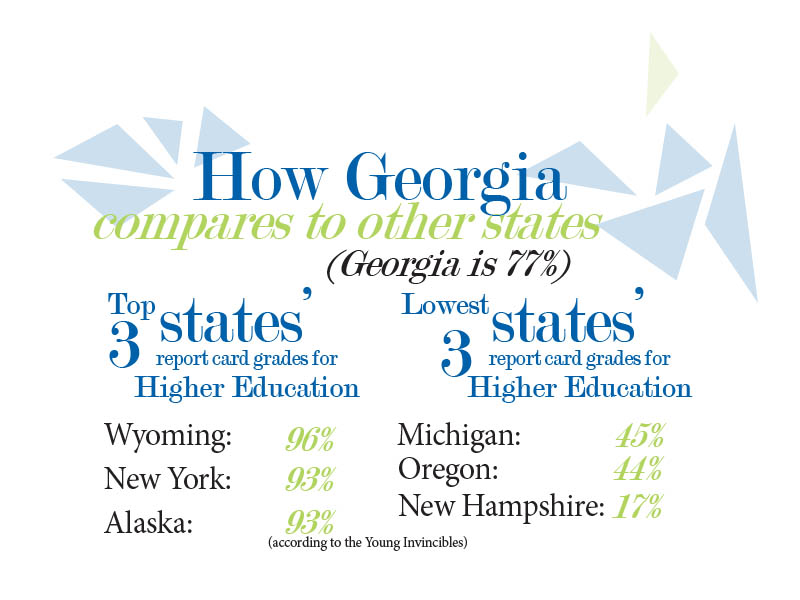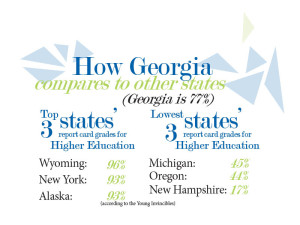

The state of Georgia received 77 percent (or C) on its “report card” for public higher education support. The ranking was based on five subjects factored and averaged into a grading system according to the Young Invincibles.
Young Invincibles is a national organization representing ideals of 18-34 year-olds in places where future decisions are made, according to the Young Invincibles’ website.
‘Tuition,’ ‘spending per student’ and ‘burden put on families’ were Georgia’s three subjects receiving F’s, according to the Young Invincibles.
“Families and students pay 40 [percent] the cost of educating their student, below the national average. But, this has increased 114 [percent] since the recession,” the report card stated in the comments under ‘burden put on families.’
However, the state earned two A’s with the subjects ‘state aid provided to students’ and ‘education as a state priority.’
“GA ranks high in terms of state budget allocation for higher ed and student aid,” the report card stated in the comments under the final grade. “Nevertheless, funding has decreased and the financial burden on families has more than doubled since the recession.”
Publicly available datasets were used to create each state’s grades which came from College Board, the State Higher Education Executive Officer’s Association, and the National Association of State Student Grant and Aid Programs. Data from the Project on Student Debt was also used, according to the Young Invincibles student impact project grading system methodology.
How data was recorded
This data was then indexed into more understandable scores of 0-100, according to policy and research manager for Young Invincibles Tom Allison.
Allison said the goal of the report card was to provide context and to simplify a complicated subject.
“Every state in the country reacted differently to the Great Recession and cut support and raised tuition in different ways,” he said. “We want these report cards to help stdents advocate their state lawmakers to invest more in public higher education.”
Wyoming had the best report card score with 96 percent. New Hampshire had the lowest report card score of 17 percent, according to the Student Impact Project by Young Invincibles.
The way Georgia’s college funding is determined
Charles Sutlive, Vice Chancellor of Communications for the University System of Georgia (USG), said funding for higher education in the state is determined after the Board of Regents (BOR) submit a budget request to the governor and Georgia General Assembly.
“The request is based on student enrollment and costs to serve students,” he said. “The Governor and General Assembly consider the needs of the University System along with all other state agencies and recommend and provide resources as available.”
The governor, General Assembly and BOR then uses various factors to determine the amount of funding each institution receives. Some aspects considered are enrollment, building space and the specific needs of the institution, according to Sutlive.
Sultive said the average amount of state funds provided per student is $4,000 but the amount of state funding per student also varies among the 30 different institutions within Georgia.
The BOR sets tuition prices using the prior year’s amount plus or minus any changes, according to Sultive.
“The changes affecting tuition are largely attributable to decisions made regarding state funding and the total need to operate institutions,” he said.
Sutlive also said the BOR has been focused on lowering costs for students and making college as affordable as possible.
“For example, for the past three years, most of the University System’s students have benefited from the lowest tuition increases in a decade,” he said.
What Georgia’s score indicates
Allison said he has mixed feelings about Georgia’s ranking because the state’s rapid rate of growth is unsustainable. He also said Georgia’s tuition is relatively low compared to the national average.
Georgia’s HOPE programs make college affordable for students but it would be more effective to just offer support to students who meet need-based criteria, according to Allison.
“So Georgia could be doing worse, but I don’t think ‘average’ is good enough for most Georgians,” he said.
He also said legislatures should reinvest in higher education.
“Nothing is more important for the future of the state than an educated and skilled workforce and that starts with post-secondary education,” he said.
Freshman nursing student Regine Thompson said the cost of tuition and fees makes it hard for her to continue attending Georgia State.
“I feel like all this money is coming out of my pocket for stuff I am not even using,” she said. “It makes me kind of want to go to a community college or something.”
Thompson also said she doesn’t receive substantial federal aid based on her parents’ salaries and urges for Georgia to raise federal aid.
“Your parents look at it as once you are 18 you are on your own,” she said. “So, I feel like what my parents do shouldn’t have anything to do with how much money I should be getting.”
She also said she doesn’t know how the specifics about Georgia’s higher education appropriations process.
How can students get involved
Jasmine Hicks, higher education campaign director for Young Invincibles, said their organization has tried to serve as a bridge to educate students on details about higher education.
“Sometimes it’s not as simple as it can be and — you know — if you are not a very political student … sometimes it’s hard to get that information,” she said. “But then also working with organizations like ours who are trying to help students better understand it and really understand, they have a place in this debate because ultimately the cost will fall on students.”
Hicks also said students learn more about what’s going on by engaging with administration and the Student Government Association. This includes talking to other students and reading the local news.
To get involved in the legislation process, students should start with conversations with legislators, according to Hicks.
“When we started the campaign last year we actually brought students to the Capitol to speak with legislators,” she said. “We really hope students try to understand how the decisions that are being made can affect their lives and then how it relates to their story.”
She also said multiple students shared their stories about struggling to obtain affordable college and the costs of student loans.
“And we are able to get these stories placed in like media outlets and gain attention to get the eyes of a lot of people that are making the decisions,” Hicks said.
Students should talk to administrators or lawmakers on the higher education committee or appropriations committee to become more educated about college funding in their state, according to Hicks.
Hicks urges students on campus to create awareness events informing other students about college affordability and student loan debt because it can be complex to understand a state’s practices for higher education funding.
“I think a lot of times it seems like they are so removed from the process. You have new young adults, folks who are 18 [and] 19 making financial decisions that will ultimately affect their futures,” she said. “And I think the general message in the last 10 years was to just go to school and get an education and you will be fine. That message is really changing because of the student loan debt and the economy.”
